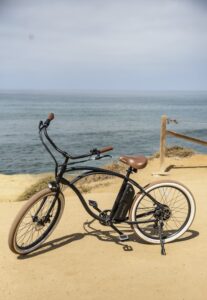Tips for Older Cyclists
As you get older, staying active can get harder. The older you get, your muscle and bone structure decline. You may experience pains and aches which can prevent you from desiring to exercise.
Arthritis is one of the medical conditions that can affect you in your old age. It can limit your mobility and reduce your ability to exercise as you used to. Cycling reduces the tear and wear of your body as well as increasing your heart rate.
Here are some tips to help you protect your joints and ride safely in your old age:

- Protect your Knees
When pedaling, it is important to get your form right. Ensuring that your knees are stable protects them from aching as you get more power in your pedal stroke.
As you ride, there should be a straight line between your shin and your thigh. If your knee pushes outward or rolls inwards, the kneecap doesn’t move smoothly.
and if you are suffering from any inflammation, this could negatively affect your cartilage. To improve movement in your knee, your seat should be kept farther back. If you sit near the handlebars, the angle of your knees is changed and this can be uncomfortable.

- Try an Electric Bike
Using an electric bike will add a boost to your ride. With this type of bike, you do not need to pedal to move for
ward. However, it will not give you the aerobic exercise that you may need.
A better way to make use of this bike is when pushing the pedals, allow it to help you. This can reduce the load especially if you are tired. Electric bikes can also help you ride easily through obstacles including steep hills.
- Keep your Bike in Good Shape
Ensure that the condition of your bike is good, especially if you have been riding it for the last 20 years or so. Your bike should be maintained and examined by a professional to avoid accidents that can be caused by malfunctioning equipment.
Your bike should be the right size for you. Find an expert to assess if the bike fits you. If it is not the right size, it may not be safe for you and can cause undue pains and aches.
You might need to buy a newer model if you are still riding on an old bike. This is because modern bikes are easier and lighter to ride around than older models.
Also, you may need to change your seat. A wider seat will help improve your balance and be more comfortable when riding.
- Take it Easy
When cycling, do not be too hard on yourself. If you experience any pain or muscle cramps, pay attention to it and do not choose a strenuous route.
Listen to your body and slowly build up your skill and endurance as you increase your effort, distance and speed. If you are not sure whether cycling is safe for you and your health, seek advice from your doctor.
- Ride with Friends
Just like exercise, socializing can help minimize cognitive decline that is related to age. Interacting with other people can slow the development of Alzheimer’s disease.
Riding with friends can improve your self-confidence and even minimize depression, anxiety and social withdrawal. Therefore, socializing can help you live a better life in your old age.
However, if your friends don’t like riding, consider joining a bike club in your community. Here, you can meet new people and be more motivated to ride.
- Stay Cautious

Cyclists are required to adhere to road rules and watch out for any obstacles and drivers. However, with age, your vision may decline and you may need to be more careful.
Regularly visit your eye doctor for check-ups and if need be, wear contacts or glasses to improve your vision. To remain safe, ride only on bike paths as they are separated from the main road.
For a smooth ride, paved areas are better compared to dirt paths. Even though you have reflectors or light, it is safer to ride during the day. Ensure that you are wearing a helmet and bright clothing.
- Dealing with Balance Concerns
If you struggle with balance, consider riding a stationary bike in a fitness centre, a gym or your home or join a spinning class. If need be, ask for help with dismounting and mounting your bike.
Keep your bike at a level where your weight doesn’t shift as you pedal. Practicing yoga can also help with balance.
You can also get the riding experience you want with a tricycle or recumbent bike without fearing to fall.
Tricycles offer stability so that you don’t worry about maintaining balance. On the other hand, recumbent bikes take the weight off your hands, your rear end and your back.
- Take Rest Seriously
Enough rest allows your body to perform better. Ensure that you get enough high-quality rest. Take some days off if you ride hard a few days a week.
Exhaustion can negatively impact your mental and physical performance. This means that you can easily get injured or be involved in an accident.

- Fuel your Body
When you were younger, you could easily exercise on an empty stomach. However, with old age, your body is less forgiving. If you do not fuel your body, you might feel lightheaded or dizzy when riding.
Before you get on a bike, ensure that you eat carbohydrates. Carry some snacks with you in case you start feeling weak. As you age, your riding performance can be improved by eating a balanced diet.
It is also important to stay hydrated. Carry a hydration pack which you can sip water while riding without losing balance. You can also take a water bottle.
- Maintain a Comfortable Speed
To maintain a fluid motion as you move your legs and knees, it is necessary to ride at a comfortable speed. It can be dangerous to pedal under 60 revolutions per minute. 80 revolutions per minute and above is recommended.
If you are a beginner, it may be sound scary but with proper riding, you can get to 80 revolutions in a minute. Ensuring that you are in a proper gear is a trick you can do to maintain this speed.
It is necessary that the speed you ride in is comfortable. If it is hard for you to ride at the recommended pace, an electric bike can provide the mechanical assistance that you need.
- Consider Kinesio Tape for Long Rides
If your knees are very sensitive and you are planning for a long ride, consider purchasing a Kinesio tape, also called elastic therapeutic tape. It pushes your knees in right alignment by supporting your muscles and joints.
Kinesio tape mimics your skin, unlike the traditional athletic tape. This allows for better movement and flexibility. It can also reduce pain in the knees.
- Get a Pre-Ride Check-Up
Visit your doctor first before getting a new bike and all the fun accessories. If you have chronic pain issues or arthritis, you may need to follow special instructions from your doctor before you start riding.
If your doctor finds a problem, you may need medication, physical therapy or operation. This means that you will not worsen the problem by riding blindly.
- Choose an Ergonomic City Bike
City and comfort bikes are designed in a way that allows you to ride when you are in an upright position. For seniors, a good sitting position is needed to prevent lower back pain.
- Start with Flat Terrain
As a senior rider, you should not start with riding on mountain trails especially if it has been a while since you were on the road. Start with riding around the local park that has a flat terrain. Riding on paved paths is easier for your knees, back and joints.
- Add Other Workouts to Your Routine
Finding the right posture and bike can keep your body in good shape, but one type of exercise can be difficult for your body whether you are old or young.
Apart from cycling, add some yoga, endurance training or water aerobics to your workout routine. Talk to your trainer to suggest what older cyclists training can look like.
- Remember to Recover

Recovery for older cyclists and being hydrated is necessary. When you get home from a Sunday ride, cool down with a sports drink and a snack filled with protein.
Thereafter, take a warm bath that has Epsom salt. This will help in promoting the recovery of your muscles.
Final Thoughts
Whether you have been cycling for years or just started, you do not have to stop because you are getting older. And if you haven’t cycled before, it is not too late to get started.
By following the above tips and making a few changes, you can be sure to improve and enjoy your riding experience. Being a senior cyclist can be a fun way to pass time and burn calories since the time of marathons and long and adventurous hikes are behind you.
With the right posture, bike and recovery, you can continue enjoying cycling into your golden years.
